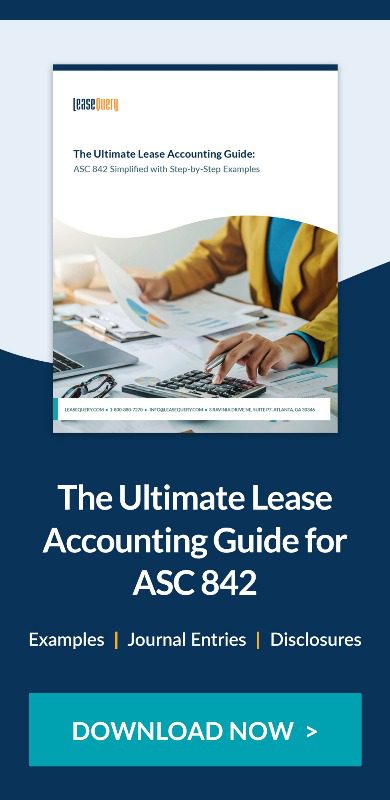This article will discuss how to account for a lease when the tenant expands the leased premises outside of the terms of the initial lease. In this scenario, the lessee decided to expand the leased property but had no obligation or right to do so in the original lease agreement.
When a lease is amended to expand the leased premises, the amendment may be considered a new lease agreement. Under ASC 842 specific criteria exist for triggering a separate lease for accounting purposes.
Accounting for amendments resulting in additional assets under ASC 842
Under ASC 842, when a tenant expands an existing lease, certain criteria have to be met to treat the amendment as a new lease versus a modification of the existing lease. A lease amendment must do both of the following:
- Grant the lessee an additional right of use, not specified in the original contract, and
- Require lease payments for the additional right of use equivalent to the standalone price for the additional right of use, including adjustments for conditions unique to the contract.
To explain further, the amendment must include an additional right of use asset with payment similar to what would be required for the same asset under a standalone contract. However, some amount of variance to the standalone pricing may be appropriate if supported by the circumstances of the contract.
The following example will illustrate the accounting according to ASC 842 for a lease amendment resulting in the right to use an additional asset or assets.
Example: Accounting for amendments resulting in obtaining an additional asset under ASC 842
Assume XYZ, Inc. enters into a 10-year lease with a landlord for one floor of a building with the following terms:
- Payments: $15,000/annually, paid on the 1st of each year
- Lease Term: 10 years, commencing January 1st
The lease is classified as an operating lease and the incremental borrowing rate in effect at the start of the lease is 5%. The lessee calculates the lease liability as the present value of the remaining lease payments, which equals $121,617. This is also the starting value for the right-of-use (ROU) assets. The journal entry to record the initial balances of the right of use (ROU) asset and lease liability is:

The full amortization schedule for the lease liability and ROU asset is shown annualized below:

Next, on January 1 of Year 2, due to a growing internet sales business, XYZ, Inc. signs an amendment to the original lease to rent an additional floor in their current building with the following terms:
- Payments: $14,000/year
- Lease amendment effective date: January 1, Year 2
- Discount rate: 6.25% incremental borrowing rate
The payment terms for the lease of space under the original lease remain unchanged. XYZ, Inc. obtains access to the second floor and the end date of the contract for the total leased premises remains unchanged.
To apply the correct accounting treatment under ASC 842, XYZ, Inc. must determine if the amendment meets the criteria for a new lease. In order for the amendment to be considered a new lease for accounting purposes, the amendment must grant XYZ, Inc. an additional right of use which was not part of the original contract and the payment terms must be equivalent to a standalone lease agreement.
The amendment in this example is for the use of an additional floor of space. The option to lease the additional floor was not mentioned in the original contract. Thus, the amendment is providing XYZ, Inc. with an additional right of use and the first criteria for a new lease is met.
The second criteria is for the payment terms to be commensurate with a standalone lease agreement for a similar asset. In this scenario, the original lease for office space was for $15,000/year. The original lease was for a single floor and represents a standalone lease. The amendment offers the additional floor at a rate of $14,000/year. The reduction in payment is not a significant departure from the payment terms of the original lease and may represent a portion of the benefit gained by the landlord for not having to locate a new tenant.
As a result of the amendment meeting both criteria for a new lease agreement, the original amortization table and accounting for the lease of the first floor will not change. Instead, XYZ, Inc. will treat the amendment as a new, standalone lease agreement. Assuming in this scenario the lease amendment also qualifies as an operating lease, XYZ, Inc. must now calculate the lease liability and ROU asset for the new lease.
The lease liability for the amendment is the present value of the payments over the remaining nine years of the lease term at the discount rate of 6.25%, calculated to be $100,083. The ROU asset is equal to the lease liability, and therefore the entry to record the lease amendment as a separate lease is:

The amortization schedule for the amendment as a separate lease under ASC 842 is below:

Summary
A lease amendment that increases the lessee’s original rights may be considered a new lease. Under ASC 842, specific criteria exists for triggering a separate lease for accounting purposes. For a lease amendment to be accounted as a separate lease, the amendment must grant the lessee an additional right of use, not specified in the original contract and require lease payments for the additional right of use to be equivalent to the standalone price for the additional right of use. If it is determined a separate lease exists, the accounting treatment for the original lease is unchanged, and the lessee must account for the modification by creating a new lease amortization schedule under ASC 842. This accounting treatment also applies if the tenant expands their lease with an amendment for more space in a completely different building, as long as it is leased from the same landlord.







